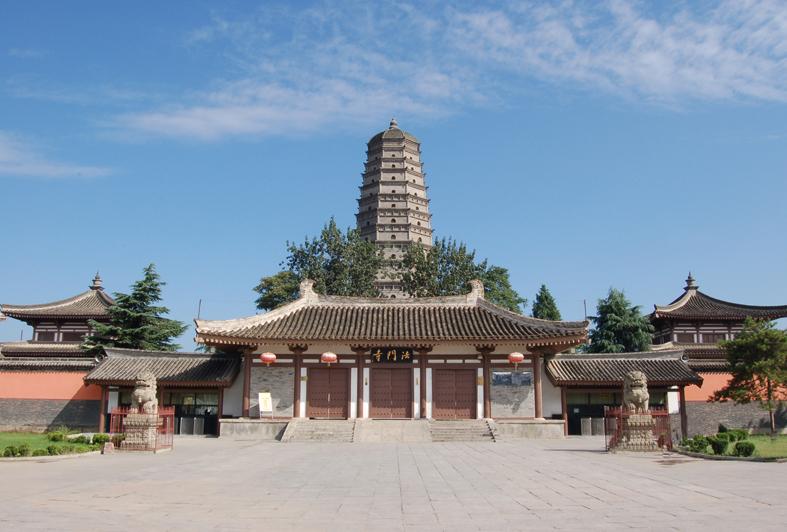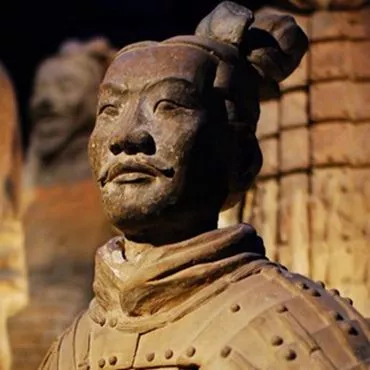Famen Temple

Famen Temple, also known as Fayun Temple or Ashoka Temple, is nestled in Famen Town, just 10 kilometers north of Fufeng County in Baoji City, Shaanxi Province. Some historians trace its origins back to the late Eastern Han Dynasty during the reign of Emperor Huan and Emperor Ling, earning it the revered title of the “Ancestral Temple of Pagodas in Guanzhong.” After the Buddha, Shakyamuni, entered Nirvana, his remains were cremated, leaving behind sacred relics, or śarīra. To propagate the teachings of Buddhism, Emperor Ashoka of India distributed these relics across the world. Famen Temple was established to enshrine these sacred relics, with the pagoda constructed to honor them and the temple built around the pagoda. In 1987, a chance discovery of an underground palace beneath the temple astonished the world, revealing the true relic of the Buddha’s finger bone, along with thousands of rare Tang Dynasty treasures, including the national treasure, the “Eightfold Treasure Chest,” which encased a shadow of the relic, and a copper stupa. This discovery elevated Famen Temple to an esteemed status in the realms of Buddhism, academia, and archaeology.
Architectural Splendor
Today, Famen Temple preserves the classical layout of a pagoda in front and a hall behind. The central axis of the temple is dominated by the Precious Pagoda of the True Relic, flanked by the Mountain Gate and Front Hall, with the Great Buddha Hall standing majestically behind the pagoda. This arrangement epitomizes the architectural style of early Chinese Buddhist temples. However, it is important to note that the tourist attractions outside the original temple grounds do not fall under the temple's jurisdiction.
The Precious Pagoda of the True Relic has undergone several transformations throughout its history. Originally a four-story pavilion-style pagoda during the Tang Dynasty, it evolved into a thirteen-story brick pagoda in the Ming Dynasty. Today’s pagoda is a reconstruction based on precise measurements of the Ming structure before it collapsed, with a steel-reinforced concrete core covered in blue bricks. Within the pagoda, a viewing platform has been added, offering visitors a chance to ascend and take in the breathtaking scenery.
The underground palace has been meticulously restored to its original Tang Dynasty state, with only severely damaged sections replaced. Constructed from white marble and limestone slabs, the palace is adorned with intricate carvings on its inner walls and stone doors. During the restoration, a circular underground chamber surrounding the Tang palace was created, complete with niches for Buddha statues. The only surviving Buddha finger relic was once enshrined in the center of this underground palace. However, after the completion of the Hehe Śarīra Pagoda, the relic was transferred there for worship.
On the temple's western side stands the Famen Temple Museum, which now houses a multifunctional reception hall, the Treasure Pavilion, and other significant structures.
Cultural Treasures of Famen Temple
Śarīra Relics
Between May 5 and 12, 1987, as the underground palace of Famen Temple was revealed to the world, four śarīra relics were uncovered. Among these, two were crafted from white jade, while another belonged to a revered monk. These three, known as "shadow bones," were placed alongside the "true bone" to safeguard the latter. The true bone is yellowish, with a texture resembling osseous granules. It is slightly curved at the top, with three flat sides and a slightly elevated surface on one side, dotted with tiny white specks of mold. The true bone measures 40.03 millimeters in length, 12.11 millimeters in width at the top, with an upper cavity diameter of 13.75 millimeters and a lower cavity diameter of 16.5 millimeters, weighing 16.2 grams. After careful examination, experts confirmed this relic as the genuine finger bone of the Buddha, making it an unparalleled, sacred artifact of the Buddhist world. With the discovery of this relic, Famen Temple ascended to the status of a holy site in Buddhism, revered across the globe.
The Eightfold Treasure Chest
The Eightfold Treasure Chest is a marvel of craftsmanship, comprising eight nested chests of varying sizes, each revealing a dazzling brilliance as it is opened. From the outermost to the innermost, the chests are as follows: the eighth layer is a sandalwood chest with silver-plated edges. This exquisite lacquered wooden chest, measuring 30 centimeters in length, width, and height, is adorned with intricately carved silver corners and crafted from the rarest sandalwood. The inner walls are coated with black lacquer, polished to a gleaming finish. The chest’s cover is designed with beveled edges, giving it a distinctive top. However, when discovered, this wooden chest was severely decayed. The seventh layer is a silver chest with gilt figures of the Four Heavenly Kings on its lid. The sixth is a plain silver chest, while the fifth features a silver chest with a gilt figure of the Buddha delivering a sermon. The fourth is a pure gold chest topped with a six-armed Guanyin figure. The third is a solid gold chest adorned with jeweled pearls, while the second layer is a stone chest encased in gold and encrusted with pearls. Finally, the innermost layer reveals the first chest, a single-eaved, four-doored pure gold pagoda with a soaring eave and a small silver pillar standing just 11 centimeters tall at its base.
Gold and Silver Ware
The underground palace of Famen Temple also housed over 120 sets of gold and silver ware, each of extraordinary archaeological value. These artifacts, often inscribed with detailed engravings, were meticulously crafted as ceremonial objects for the Emperor’s offering and retrieval of the Buddha’s relics. The exquisite workmanship of these pieces not only reflects the artistic genius of their creators but also provides crucial clues for identifying their owners and determining their historical period. Among these treasures were numerous tea sets, including tea grinders and bowls, all of which are masterpieces of cultural and artistic significance.
Porcelain
Before the opening of Famen Temple’s underground palace, the nature of mìsè porcelain was shrouded in mystery. Some believed that the term referred to a secret glaze color, while others speculated it was a specific hue. However, inscriptions found in the palace, along with the unearthing of thirteen mìsè porcelain pieces, finally solved this ancient riddle. Among these, the mìsè octagonal pure water vase stands out. It contained 29 multicolored Buddhist beads, capped with a large crystal bead at its mouth. The vase’s celadon glaze is exceptionally bright and smooth, surpassing the quality of other mìsè pieces, with its well-proportioned shape and flawless craftsmanship representing the pinnacle of Tang Dynasty porcelain. It is considered one of the most outstanding and iconic examples of mìsè porcelain. The discovery of mìsè porcelain at Famen Temple has revolutionized Chinese ceramic archaeology, resolving long-standing debates within the field. It confirms that mìsè porcelain production began in the late Tang Dynasty, reaching its zenith during the Five Dynasties, and providing definitive criteria for identifying the era and characteristics of this exquisite porcelain.
In summary, Famen Temple, with its profound history, sacred Buddhist relics, and unparalleled significance in both the Tang Dynasty and modern times, has rightfully earned its place as one of the most revered Buddhist sanctuaries in the world.















